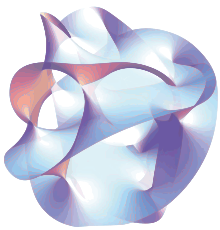Green–Schwarz mechanism

Multi tool use
| String theory |
|---|
 |
Fundamental objects |
|
Perturbative theory |
|
Non-perturbative results |
|
Phenomenology |
|
Mathematics |
|
Related concepts
|
Theorists
|
|
The Green–Schwarz mechanism (sometimes called the Green–Schwarz anomaly cancellation mechanism) is the main discovery that started the first superstring revolution in superstring theory.[1][2]
Discovery
In 1984, Michael Green and John H. Schwarz realized that the anomaly in type I string theory with the gauge group SO(32) cancels because of an extra "classical" contribution from a 2-form field. They realized that one of the necessary conditions for a superstring theory to make sense is that the dimension of the gauge group of type I string theory must be 496 and then demonstrated this to be so.
In the original calculation, gauge anomalies, mixed anomalies, and gravitational anomalies were expected to arise[3] from a hexagon Feynman diagram. For the special choice of the gauge group SO(32) or E8 x E8, however, the anomaly factorizes and may be cancelled by a tree diagram. In string theory, this indeed occurs. The tree diagram describes the exchange of a virtual quantum of the B-field. It is somewhat counterintuitive to see that a tree diagram cancels a one-loop diagram, but in reality, both of these diagrams arise as one-loop diagrams in superstring theory in which the anomaly cancellation is more transparent.
As recounted in The Elegant Universe's TV version, in the second episode, "The String's the Thing", section "Wrestling with String Theory", Green describes finding 496 on each side of the equals sign during a stormy night filled with lightning, and fondly recalls joking that "the gods are trying to prevent us from completing this calculation". Green soon entitled some of his subsequent lectures "The Theory of Everything".
Details
Anomalies in quantum theory arise from one-loop diagrams, with a chiral fermion in the loop and gauge fields, Ricci tensors, or global symmetry currents as the external legs. These diagrams have the form of a triangle in 4 spacetime dimensions, which generalizes to a hexagon in D = 10, thus involving 6 external lines. The interesting anomaly in SUSY D = 10 gauge theory is the hexagon which has a particular linear combination of the two-form gauge field strength and Ricci tensor, F6, F4R2, F2R4, R6{displaystyle F^{6}, F^{4}R^{2}, F^{2}R^{4}, R^{6}}
Green and Schwarz realized that one can add a so-called Chern–Simons term to the classical action,
having the form SGS=∫B2∧X8{displaystyle S_{GS}=int B_{2}wedge X_{8}}


a gauge invariant combination of F4, F2R2, R4{displaystyle F^{4}, F^{2}R^{2}, R^{4}}
If the variation of B2{displaystyle B_{2}}

the Green–Schwarz term SGS{displaystyle S_{GS}}
References
^ Green, M. B.; Schwarz, J. H. (1984). "Anomaly cancellations in supersymmetric D = 10 gauge theory and superstring theory". Physics Letters B. 149: 117. Bibcode:1984PhLB..149..117G. doi:10.1016/0370-2693(84)91565-X..mw-parser-output cite.citation{font-style:inherit}.mw-parser-output q{quotes:"""""""'""'"}.mw-parser-output code.cs1-code{color:inherit;background:inherit;border:inherit;padding:inherit}.mw-parser-output .cs1-lock-free a{background:url("//upload.wikimedia.org/wikipedia/commons/thumb/6/65/Lock-green.svg/9px-Lock-green.svg.png")no-repeat;background-position:right .1em center}.mw-parser-output .cs1-lock-limited a,.mw-parser-output .cs1-lock-registration a{background:url("//upload.wikimedia.org/wikipedia/commons/thumb/d/d6/Lock-gray-alt-2.svg/9px-Lock-gray-alt-2.svg.png")no-repeat;background-position:right .1em center}.mw-parser-output .cs1-lock-subscription a{background:url("//upload.wikimedia.org/wikipedia/commons/thumb/a/aa/Lock-red-alt-2.svg/9px-Lock-red-alt-2.svg.png")no-repeat;background-position:right .1em center}.mw-parser-output .cs1-subscription,.mw-parser-output .cs1-registration{color:#555}.mw-parser-output .cs1-subscription span,.mw-parser-output .cs1-registration span{border-bottom:1px dotted;cursor:help}.mw-parser-output .cs1-hidden-error{display:none;font-size:100%}.mw-parser-output .cs1-visible-error{font-size:100%}.mw-parser-output .cs1-subscription,.mw-parser-output .cs1-registration,.mw-parser-output .cs1-format{font-size:95%}.mw-parser-output .cs1-kern-left,.mw-parser-output .cs1-kern-wl-left{padding-left:0.2em}.mw-parser-output .cs1-kern-right,.mw-parser-output .cs1-kern-wl-right{padding-right:0.2em}
^ Clifford V. Johnson, D-branes, Cambridge University Press, 2003, section 7.1.4.
^ Frampton, P.; Kephart, T. (1983). "Explicit Evaluation of Anomalies in Higher Dimensions". Physical Review Letters. 50 (18): 1343. Bibcode:1983PhRvL..50.1343F. doi:10.1103/PhysRevLett.50.1343.
9aq8Zc,7z3fK Z,vpwkpQ1MlXP3pmHpzVqJSALxqjdgLag,i9pbiD4,j